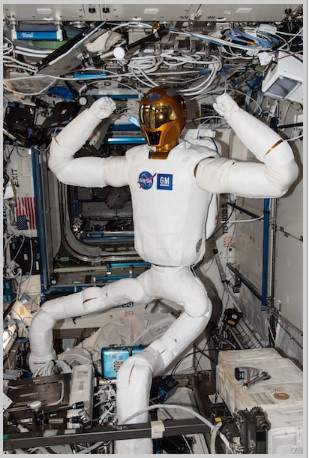Robonaut 2
Source: NASA
MISSION
Robonaut 2, or R2, developed jointly by NASA Johnson Space Center (JSC) and General Motors (GM) is a highly dexterous anthropomorphic robot designed to perform simple tasks, and act as an assistant to human operators. R2 was launched to the International Space Station (ISS) aboard the STS-133 Space Shuttle mission in 2011. In 2014, a mobility platform was added to R2, which was initially deployed as a torso-only humanoid restricted to a stanchion. R2 was augmented with two new legs for maneuvering inside the ISS. R2 is the first dexterous anthropomorphic robot in space, and the first US-built robot at the space station. R2 is a permanent resident at the ISS. [1]
R2 is made up of multiple component technologies and systems -- vision systems, image recognition systems, sensor integrations, tendon hands, control algorithms, and much more. R2's nearly 50 patented and patent-pending technologies have the potential to impact a number of industries, including logistics and distribution, medical and industrial robotics, as well as hazardous, toxic, or remote environments. [2]
SIGNIFICANCE
The greatest benefits of humanoid robots in space in the future may be as assistants, or stand-in for astronauts during spacewalks, or for tasks too difficult or dangerous for humans. With near human level dexterity, the Robonaut 2 can potentially take on simple, repetitive and dangerous tasks typically done by humans, while using the same tools as a human astronaut. Robonaut 2 could also potentially serve during a robotic precursor mission, where R2 would bring a set of tools for the precursor mission, such as setup or geologic investigation. Future missions could then supply additional tools. [3]
NASA wants to use Robonaut as a testbed to develop future robotics technology for space outposts on the moon and Mars, such as the lunar Gateway. Gateway is a planned orbiting facility near the Moon that would serve as a starting point for missions to cis-lunar space and beyond. In contrast to the International Space Station (ISS), which is continuously manned, the Gateway is expected to be only intermittently occupied by humans – with astronauts on board for only short periods of time, perhaps only 1 month per year. So there is a need for robotic/ autonomous capabilities that will do things that need to be done when there are no humans on board. [4] While Gateway is still a few years out, it’s clear that robotics will be an integral part of NASA’s plans to expand beyond low Earth orbit. [5]
TEAM
NASA’s Johnson Space Center (JSC) and General Motors (GM) teamed up to create the R2, with the Software, Robotics, and Simulation Division within JSC’s Engineering Directorate serving as the lead. The team also received help from Oceaneering Space Systems engineers. [6]
SPECIFICATIONS
- Materials: Primarily aluminum with steel, and non-metallics
- Weight: 330 pounds
- Height: 3 feet, 4 inches (from waist to head)
- Shoulder width: 2 feet, 7 inches
- Sensors: 350+, total
- Processors: 38 Power PC Processors
- Degrees of freedom: 42, total
- Speed: Up to 7 feet per sec [7]

Source: NASA
DEVELOPMENTS
On February 24th, 2011, the final Space Shuttle mission launched, carrying Robonaut to the International Space Station (ISS), where it will permanently reside. [8]
In March 2012, Robonaut 2 performed its first real work onboard the ISS. R2 was tasked with measuring air velocity from an air vent inside the Destiny lab. This task, while seemingly mundane, is the type of everyday task R2 was designed to perform. Astronauts have to measure the airflow in front of vents inside the station to ensure that none of the ventilation ductwork gets clogged or blocked. Robonaut is particularly well suited to this task, as it requires the air velocity sensor to be held perfectly still and no air disturbances, which can be difficult for a living, breathing astronaut floating in microgravity. R2 successfully took the air velocity reading, and while it took much longer to accomplish this task than a human astronaut would need, it was a successful demonstration of Robonaut’s ability to use tools and accomplish needed tasks aboard the ISS. [9]
In December 2013, NASA announced its engineers were developing the climbing legs for R2. The new legs will enable R2 to help with regular and repetitive tasks inside and outside the ISS. The goal of this initiative is to free up the crew for more critical work, including scientific research. [10]
In August 2014, the climbing legs that were built by NASA were attached to R2 on the ISS. Although the legs are designed to work both inside and outside the station, additional upgrades are required to R2’s upper body to allow it to work outside the space station. [11] The leg upgrade encountered problems, however, and as a result Robonaut was largely disabled from 2015 through early 2018. [12]
In February 2018, NASA announced that it is bringing Robonaut back to Earth to be fixed. Robonaut was sent home on the SpaceX CRS-14 Dragon cargo spacecraft, arriving back at the Johnson Space Center (JSC) in May 2018. Once in the lab, engineers found that the root cause of the problem was a missing return wire in the power supply for the robot’s computer chassis. Current was instead using a “sneak circuit” that overheated a connector in Robonaut’s backpack. [13]
In August 2019, it was reported that engineers overhauled Robotnaut’s electrical system, work that identified three more potential sneak circuits that could have posed problems for the robot. They also performed other upgrades to the robot’s hardware and software. R2 is expected to return to the International Space Station (ISS) after repairs on the ground have been completed. [14]
Updated November 2022 by Kristin Stiner


Comments are closed.